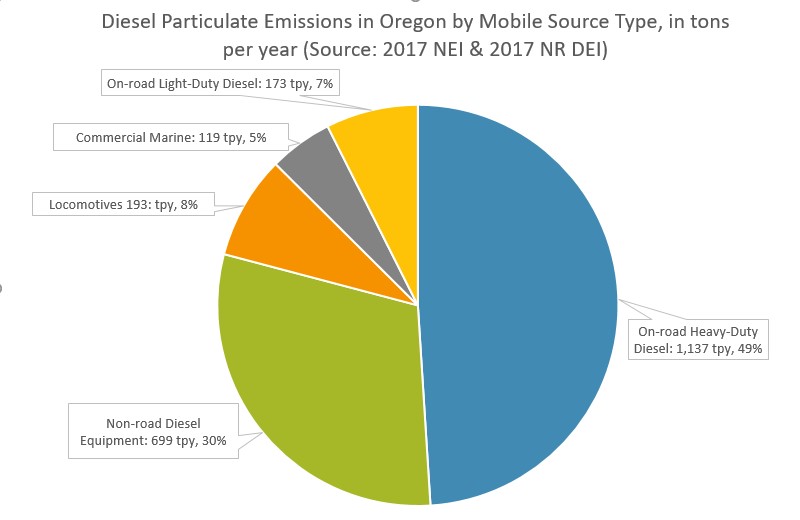2017 National Emissions Inventory
EPA conducts the National Emissions Inventory every three years, with significant input from each state. Typically, results are released two-and-a-half years after the inventory year ends. Oregon's most recent diesel emissions inventory data comes from the 2017 NEI, which was released in April 2020.
The pie chart below shows the statewide sector breakdown of the 2,322 tons of diesel particulate matter emitted across Oregon in 2017. [Embed pie chart here] For more detailed county-level information, please visit the
EPA's 2017 NEI Data web page.
Note: Data shown here includes results from the 2017 NEI and the 2017 Oregon Non-Road Diesel Emissions Inventory (see below for detailed description).

Non-Road Diesel Emission Inventory
The air quality estimation tool for non-road mobile sources of emissions is the EPA developed NONROAD tool. This tool relies upon default values for equipment population counts and activity levels derived from surveys conducted by EPA, as well as local knowledge when available. The tool's ability to reflect emissions in any given geographic area is dependent upon the quality and specificity of the inputs provided.
DEQ completed a thorough assessment of risk from toxic air pollutants in the Portland area in 2011, highlighting diesel as a prominent risk factor for elevated cancer risk from ambient exposure. Within the range of diesel sources, non-road diesel-powered construction equipment dominated the risk exposure. Locally sourced information about on-road vehicle operation (e.g., time, volume, location, speed, etc.) is well developed, but similar high quality information was determined to be lacking for non-road equipment. Better data would not only inform further modeling efforts, but also allow more targeted and focused mitigation strategies to be implemented.
In 2017, the Oregon Legislature appropriated funds to DEQ to use a third-party contractor to conduct a statewide and multi-sector inventory of non-road diesel engines to improve upon EPA default values. The purpose of this inventory was to inform and refine air quality models based on private and public fleets currently in use. To ensure survey results were representative of the statewide inventory, data collection was conducted using a mix of sampling techniques, including but not limited to whole fleet inventories (i.e., census-style counts), representative sampling of fleets by fleet size and industry surveying. Results and assumptions were verified using existing relevant and complementary data, such as fuel use and business asset data collected by county tax assessors. DEQ consulted with interested stakeholders prior to releasing the request-for-proposal and when developing preliminary results, as well as during other specific phases of the inventory process.
Eastern Research Group, Inc., DEQ's project contractor, presented the inventory findings during a public webinar on April 29, 2020. Below are links to the slides, a recording of the presentation and the final report.
Please email any questions or comments about this project to NonroadDiesel2020@deq.oregon.gov
EPA Diesel Monitoring Grant
In 2018, the EPA awarded DEQ a $466,276 Community-Scale Air Toxics Ambient Monitoring Grant to better quantify diesel emissions from rail activity, construction, freight distribution and marine vessels. Together with research partners at Portland State University and Reed College, DEQ is attempting to develop a better understanding of diesel emissions and their sources to allow for improved insight into exposures, problems and solutions. It will also help inform and complement other diesel emissions reduction efforts, including better targeting of available grant funds toward the most impacted communities.
An additional research project goal aims to develop chemical signatures of specific sources of diesel emissions, such as rail, construction and freight distribution. Using the source data to establish chemical signatures may provide better details about exposure at the neighborhood scale.
The investigation has experienced some delays due to pandemic restrictions and the need to develop more innovative source sampling procedures. However, DEQ anticipates results from this research in 2022.
Additional Resources
National-scale Air Toxics Assessment